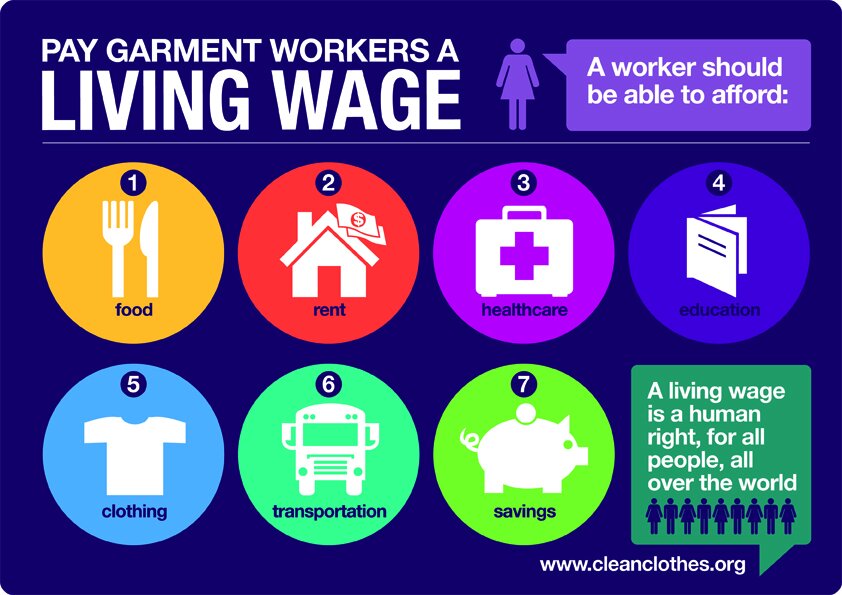SFW and the Sustainable Development Goals
In 2015, the United Nations launched the 2030 Agenda for Sustainable Development with 17 Sustainable Development Goals (SDGs) at its heart. The goals are an urgent call to action in the face of many planetary and human catastrophes; climate change, environmental degradation and extreme poverty and inequality, to name just a few.
The UN Member States pledged to “leave no one behind” as we work on improving health and education, reducing inequalities, saving our diverse ecosystems, spurring economic growth and developing sustainable sources of energy and consumption patterns. The 17 Goals can be found here, but today we focus on the goals which most urgently relate to SFW.
1) SDG 1: No Poverty
The fashion industry today thrives because it manufactures clothes based on cheap labour abroad, and sells them on for an extortionate profit. Exploitation of garment workers is a crime against humanity, and one done at the hands of rich corporations such as Boohoo and Urban Outfitters. SFW calls for living wages for all workers along the production line of clothes, and promotes those companies which do just that.
2) SDG 2, 3, 4 & 6: Zero Hunger, Good Health & Wellbeing, Quality Education and Clean Water & Sanitation
In line with the above, no poverty means becoming substantially closer to achieving healthy and happy living conditions for all. If garment workers were paid a living wage, they would (hopefully) be able to afford basic needs (food, rent, healthcare, education). Tragically, many fashion brands pay their workers a legal minimum wage which, in most manufacturing countries like Bangladesh and India, represents half to a fifth of the living wage.
SFW calls for brands to pay workers a living wage, so that they can finally experience the basic human needs which we take for granted in the west.
3) SDG 5: Gender equality
About 80% of garment workers worldwide are women. As a result, gender-based violence, sexual harassment and discrimination are sadly commonplace in clothing factories. What’s more, women are often not granted maternity leave or provided with child care facilities so they have no choice but to leave work if they have a child. Let’s not even get started on the gender pay gap.
SFW rallies against such discrimination in the workplace, urging fashion brands to call out gender inequality and seek a better working environment – and life – for women globally.
4) SDG7: Affordable and Clean Energy
The fashion industry is responsible for 8-10% of global carbon emissions. It is no secret that carbon has led to our drastically warming world: rising sea levels, causing temperamental and dangerous weather patterns and risking the habitats of species everywhere. The warming world is no joke; in A Life on Our Planet, David Attenborough explains that, if we continue as we are, by the 2100s great swathes of the planet with be uninhabitable and the sixth mass extinction will be well underway.
SFW calls for fashion brands to create clothing in a sustainable way: meaning carbon neutral.
5) SDG 12: Responsible Consumption and Production
Along the same vein, the fashion industry is a cause of substantial waste. 100 billion items of clothing are created each year, yet $500 billion worth of clothing is lost annually due to the under-utilisation of clothes and lack of effective recycling. These clothes end up in landfill and micro-plastics flood our oceans, leading to even more biodiversity loss.
SFW calls for a more sustainable and responsible attitude to our wardrobe, and ideally a circular economy where there is no room for waste.
6) SGD 13, 14 and 15: Climate Action, Life Below Water and Life on Land
The fashion industry causes great harm to our planet - and it’s as simple as that. 60% of fabric fibres are now made of synthetics meaning that the majority of fashion waste ending up in landfill will not decay, leaving a permanent scar on our landscapes. In one interview, Stella McCartney explained that “the equivalent of one garbage truck of textiles is burned or landfilled every second”. In terms of water waste and pollution, the fashion industry is a huge culprit. Shockingly, it takes 2,700 litres of water to make one cotton shirt; enough water to sustain a human being for three years. After using this extortionate amount of water, clothing factories will release their toxic water waste back into the rivers and oceans; rendering vital sources of water unusable for local communities.
If we cannot adopt a sustainable fashion system, we will lose our planet and all the resources, life, and joy it gives us. SFW is a rebellion against the fast fashion norm which is leading to the rapid destruction of our planet.
The SGDs are interlinked, and so all the SDGs are relevant to SFW. Here we have outlined the ones which we believe are most urgent in the present moment, but we are working to incorporate all the goals within our organisation. It is in this way that we can work toward a world that is fair, sustainable and joyful.




